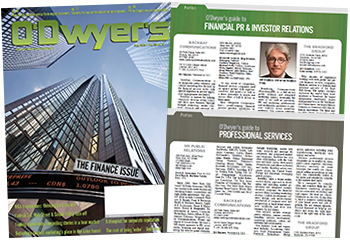 Frank Tortorici Frank Tortorici |
Everyone dreads bad news. And all public relations executives dread bad news about their clients.
But if you’re a crafty PR person, sometimes a piece of news that’s overall on the negative side can be turned into a positive story for your client.
One example that comes to mind is the preponderance of bad news about major companies being hacked by wily cyberthieves, resulting in thousands of customers’ personal information being dangerously exposed. While this kind of thievery brings comfort to no one, it presents an opportunity for PR practitioners in the cybersecurity field. Because these incidents are growing in number and damaging the reputations of once respected companies such as Target and Home Depot, CEOs and other top executives are hungry for advice regarding how to keep these cyber wolves at bay.
 |
| This article is featured in O'Dwyer's Aug. '19 Financial PR/IR & Prof. Svcs. PR Magazine. |
Enter cybersecurity experts. If you have a client that fits this description, be sure to take advantage of the cyber horror stories in the news. Pitch your broadcast and print media contacts that your expert is available to discuss the ramifications of the current cyberattack on other businesses and consumers. Put a positive spin on the bad news by having your client offer tips on how the public and corporations can best prevent such disasters.
Another type of story in which a PR pro can turn the bad into the good concerns the reporting of negative financial results for public companies. Countless PR executives are confronted with conveying disappointing corporate earnings from time to time. The skilled communicator will work to put the damage reported in perspective and craft an as encouraging message as possible to worried shareholders and stakeholders, and the media.
Identify the positive events in the company at earnings time. There’s no way to not report the negative financial numbers but coat them with details of hopeful activity on the horizon when sending reports to shareholders and when pitching reporters. Share news of new or expanded office openings, of innovative products in development that will ultimately result in better news for your shareholders, and of promotions and additions in executive staff.
By relaying news in this manner, you’re not hiding the bad news/numbers but doing your public relations duty of accentuating the positive to protect the brand and its image. In reality, you could be looking after the interest of current and future stockholders whose investments and shares may very well increase based on the rosier developments you are emphasizing.
Another example of the PR practitioner doing the job well in the face of distressing news involves responses to calamitous events in your client’s locality. Think of a situation where a toxic or poisonous substance has been reported to have been inadvertently leaked and is endangering the physical and mental well-being of a town or city.
Our agency has a client that does extensive research on asbestos contamination and legal precedents that have been set in terms of corporate litigation on such “toxic tort” cases. We jump at the chance to show how our researcher clients can add much needed perspective to any stories involving damage to property and/or individuals.
With our client’s background, it can offer examples of how the potential damage in such cases is often much worse than what is actually incurred by citizens or the government. We arrange interviews for the appropriate researchers to tell the real story of what usually happens in these incidents to local daily newspapers and nightly news programs. These experts can explain the effects of asbestos and other substances and any possible remedies, both physical and financial in nature.
It’s the duty of the PR pro to be ready for negative news events and to consider every way any clients can be called upon to add encouraging perspective. Throughout the history of publicity, the smart PR executive has taken advantage of such situations. It’s a part of the trade to inform the public of ways that it could benefit from the expertise of your client companies and it’s a component of your pact with your clients that you’ll capitalize on any chance of presenting the company or product in the best possible way.
***
Frank Tortorici is Senior Strategist of Media Relations at Marketing Maven.


 There’s a fine line between newsjacking and taking advantage, aka ambulance chasing. Our job as PR professionals is to tread it carefully.
There’s a fine line between newsjacking and taking advantage, aka ambulance chasing. Our job as PR professionals is to tread it carefully. PR firms need to be mindful of ways their work product may be protected by the attorney-client privilege whenever working with a client’s internal legal team or its external legal counsel.
PR firms need to be mindful of ways their work product may be protected by the attorney-client privilege whenever working with a client’s internal legal team or its external legal counsel. Manuel Rocha, former US ambassador and intenational business advisor to LLYC, plans to plead guilty to charges that he was a secret agent for Cuba.
Manuel Rocha, former US ambassador and intenational business advisor to LLYC, plans to plead guilty to charges that he was a secret agent for Cuba. CEO mentoring is an often-overlooked aspect of why CEOs are able to make good decisions, and sometimes make bad ones—all of which intersects with the role and duties of a board.
CEO mentoring is an often-overlooked aspect of why CEOs are able to make good decisions, and sometimes make bad ones—all of which intersects with the role and duties of a board.  How organizations can anticipate, prepare and respond to crises in an increasingly complex world where a convergent landscape of global challenges, threats and risks seem to arrive at an unrelenting pace.
How organizations can anticipate, prepare and respond to crises in an increasingly complex world where a convergent landscape of global challenges, threats and risks seem to arrive at an unrelenting pace.


 Have a comment? Send it to
Have a comment? Send it to 
No comments have been submitted for this story yet.